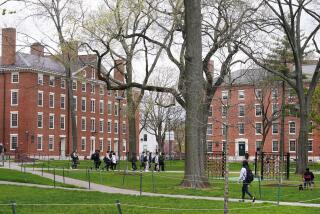CAMPUS CORRESPONDENT : Why Today’s Students Deserve Higher Grades
- Share via
NEW HAVEN, CONN. — In today’s world of instant celebrities, timing is everything, and last spring, Lon “L. T.” Grammer’s timing was impeccable. Grammer owed his notoriety to his method of earning admission to Yale University. While other students labored to improve their SATs and GPAs, he simply falsified his grade transcript and fabricated recommendations in his metamorphosis from a C-plus student to an A-plus student at Cuesta Community College near San Luis Obispo.
Grammer also became the poster boy for a new movement gaining momentum at the time he was arrested. Grammer--a C student at a community college and a B student at Yale--was held up as an example of raging grade inflation at universities across America.
There were a few problems with this argument. First, the only source who confirmed Grammer’s GPA at Yale was Grammer himself. Considering he was already accused of credit-card fraud, falsifying financial-aid records and forging his application, it is likely he would have had few qualms about cheating in school. In fact, Grammer was flunked by one professor, who brought him up before the school’s executive committee on plagiarism charges. The political science department, where Grammer was a major, asserted that he had earned a handful of Bs and a majority of Cs and Ds.
None of this seemed to matter. Editorials and letters across the country bemoaned the loss of academic standards and the decline in students’ intelligence. Grammer was an example of how students were being spoiled and awarded grades they did not deserve. It was the professors’ responsibility now to lower grades in order to stop this scourge before it destroyed the academic integrity of all universities.
Every possible explanation was offered--except one. Maybe today’s students are better. Forty years ago, most universities were exclusively white and male. Women and minorities were unheard of; Jews were limited to small quotas. Campuses were not models of diversity--racially or economically.
When schools like Yale admitted women and minorities in the late 60s and early 70s, an amazing thing happened. The student bodies grew stronger. Rather than accept the top 60 students from Exeter, universities accepted the top one or two students from a variety of high schools across the nation, diversifying and improving the makeup of the student body. With these new overachievers came an increase in the number of good grades. It makes sense that a woman who had been valedictorian of her class would work harder in school and get better grades than a man who had been 60th in his class at Exeter.
The change in the student body coincided with a change in the course curriculum. More seminars and independent-study courses were offered, and professors teaching these classes tended to award higher grades because of the classes’ small size. Also, technological advances allowed students access to word-processing equipment, which improved their ability to write, edit and turn in quality work.
When professors look at the current grade distribution in our nation’s universities, however, they cry foul. Rather than mention the quality of the student’s work, they merely complain that there are too many good grades and that some students will have to suffer. We need to return to old-fashioned, cutthroat competition, they declaim. What if there is no way to determine who is more deserving of an A because all students are doing quality work and meeting the high standards of their universities?
Has anyone ever actually looked at the work of these “undeserving” students? Stanford, for example, wants to center its grading system on the C, representing average work. But average compared to what? The class? The entire student body? How about comparing today’s students to those of previous generations?
Former Stanford professor Gerald Bracey said that when he taught in the mid-’60s, he was forced to adhere to a strict curve, according to which the bottom 50% each class got Cs, Ds and Fs. At a school where many of the entering students had never received a B in their lives, the results were tightly bunched scores and meaningless differences among many grades. It became difficult for Bracey to separate students without resorting to questions taken from trivia or footnotes. Furthermore, handing out low marks did nothing to improve student morale or intelligence, he recalled.
The changes that occurred during the ‘70s allowed for a fairer distribution of grade, which gave professors and students the opportunity to concentrate on learning, not grades. Nevertheless, public opinion still regards today’s students as sub-par academics undeserving of their achievements. To compound the slight, the Lon Grammers of the world are held up as examples of these underachievers.
It seems ironic that universities spend millions of dollars a year to recruit the best and the brightest, then get defensive when the best and the brightest do well.*
More to Read
Sign up for Essential California
The most important California stories and recommendations in your inbox every morning.
You may occasionally receive promotional content from the Los Angeles Times.













